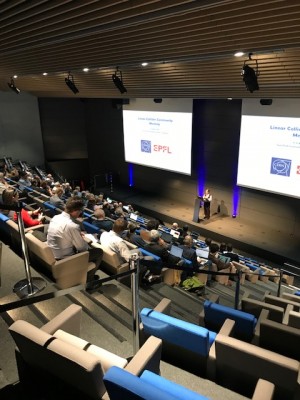 The European Strategy process (ESPP) is moving ahead, with an Open Symposium in Granada, Spain as the next main event.
The European Strategy process (ESPP) is moving ahead, with an Open Symposium in Granada, Spain as the next main event.
Preparing for this meeting and strategy discussions in general, a Linear Collider Community Meeting was held at École Polytechnique Fédérale de Lausanne (EPFL), Lausanne, Switzerland in the beginning of April. The meeting was arranged on the initiative of the Linear Collider Board (LCB) and the International Committee for Future Accelerators(ICFA), supported by the European Committee for Future Accelerators (ECFA). CERN and EPFL served as local organisers. Around 100 people participated in the meeting and contributed to lively and open discussions about future strategies.
The main objectives of the meeting were to update the community on the input made to the European Strategy process regarding linear colliders, and to discuss how best to present the case for implementing an electron-positron (e+e-) linear collider as the next large international accelerator project after the Large Hadron Collider (LHC) and High Luminosity LHC.
During the first day of the meeting the case for a linear collider and the overall plans for the European Strategy process were presented, followed by presentations of the linear collider strategy input papers and the status of the Compact Linear Collider (CLIC) and International Linear Collider (ILC) projects, covering accelerator, detector and physics studies. The projects’ plans for the next phase were also discussed, being of immediate relevance for the strategy process. The next day the preparations for the key sessions – for our community – of the Granada meeting were outlined by the conveners of the relevant working groups, and the work done to provide the linear collider input to these sessions was discussed.
The main points discussed in the Lausanne meeting were the general importance of a linear collider, supporting scientific, technical and strategic arguments, and the benefits for the field of particle physics in general by moving ahead quickly. To summarise these points, a draft document was presented on the first day as a basis for discussion. The discussion continued throughout the meeting in several dedicated sessions, and preliminary conclusions were agreed. The final document was improved in mail discussions after the meeting. The document describes the scientific rationale for a staged linear collider, emphasising the matureness and realism in implementing the first stage of a linear collider by around 2035, and how this can fit into an overall framework for the future of particle physics providing crucial scientific results for our field soon after. Additionally, a linear collider provides many opportunities for taking full advantage of further technical progress in accelerator science in the longer term, as both our scientific and technical knowledge advances. The summary document can be found here.
The hope is that the document can help to present a common vision (scientific, technical and strategic) for the linear collider community in the discussions during the Granada meeting and ESPP process in general, as well as in other interactions with linear collider stakeholders.


Recent Comments